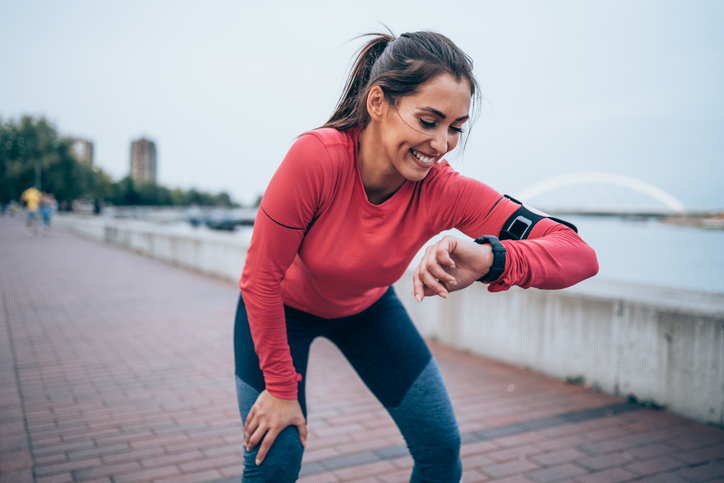Unless you’ve been living under a rock, you’ll no doubt know quite a lot about fitness trackers and smartwatches – and you probably have one. But if you’re still only using it to count calories and keep track of your daily activity, then you’re missing a trick – because over the past couple of years, they’ve come on in leaps and bounds, and now have the technology to do much more than that. According to a survey by business news site The Manifest, wearable tech isn’t just for fitness fanatics either – 56 percent of people in the UK own at least one wearable with the likes of Apple, Garmin and Fitbit reaching peak sales last year. In fact, sales of smartwatches worldwide grew an astonishing 27 percent last year according to Counterpoint Research’s recently published Global Smartwatch Model Tracker. And it’s hardly surprising when you consider what they can do. With functions from measuring stress levels to keeping track of your heart health and monitoring your periods, they can do so much. The only question is, which one is best for you? Read on for the experts’ take on which watch you should pick.
First thing’s first
Before you dive straight in, there are a few practical considerations to make:
- It sounds obvious, but make sure your smartwatch is compatible with your phone, as Apple Watches only work with the iPhone, while many others only with Android devices.
- Check the battery life – the more bells and whistles they have, the shorter their battery life.
- Wristbands tend to wear out sooner than the tech so make sure they’re easily changeable, and easy to buckle up.
- Look into the selection of apps available.
Smartwatch or fitness tracker?
Smartwatch, fitness tracker, wearable; aren’t they all the same thing? Well, no, actually, as Will Turner, CEO of GoJoe (gojoe.com), a social fitness app which motivates people to get fit, explains.
“As it sounds, a wearable is the general term for any device you wear, some of which might allow you to track health, wellbeing or fitness, and some of which allow you to connect with other devices and apps (‘smart’ watches),” he says. “Most wearables nowadays have elements of both, although the majority specialise in certain areas. To confuse matters more, as technology improves, wearables are increasingly available on parts of your body that aren’t your wrist, like rings, headbands and even socks.”
Fitness
Both fitness trackers and smartwatches are a great way of helping you to boost your fitness and making it easier to set and keep track of your goals. As well as counting steps, they can also keep you accountable for things, such as exercise (by monitoring your heart rate during a workout), track sleep and measure the number of calories burned. Many have either built-in ways of monitoring your progress, or apps you can download to do so.
“Smartwatches are great for fitness as they can help you to stay motivated as you notice yourself getting fitter,” says Beth Davies, a women’s health and fitness coach (bethdaviescoaching.co.uk).
And specialist-chartered physiotherapist Becky Sessions agrees. “The NHS advises that all adults do 150 minutes of moderate intensity exercise every week, or 75 minutes of vigorous exercise, split over four to seven days,” she explains. “The intensity is worked out as a percentage of the maximum heart rate for each individual based on their age, meaning that moderate intensity would be between 50-70 percent of the individuals’ maximum heart rate. Knowing this figure when you’re working on your fitness goals while wearing a fitness tracker means that you can ensure that you’re exercising in the right range for you because the device is continually monitoring and recording your heart rate.
“Another benefit is that you can start to notice a pattern visually, usually in a chart format, over a week, month or even year, so that you can see if you’re achieving your goals or if you need to increase them as your fitness improves, or decrease them due to illness or injury, regardless of whether you’re monitoring steps, heart rate, calories or work out times. I find that seeing the pattern can increase motivation when you can see a clear trend.” But, as Beth warns, it’s worth exercising some caution when it comes to your tracker of choice.
“One of the problems is that they can also create a narrow definition of success,” she explains. “Didn’t get your 10,000 steps? That may feel like a fail – and your tracker may remind you of this. Berating yourself because you didn’t stay in a specific heart rate zone, or you noticed your sleep wasn’t as high quality as it should be can feel highly demotivating.”
Stress and heart health
Most of the latest models offer some sort of stress monitoring, and the main way they do this is through your heart rate, via 24/7 heart rate monitors which measure the heart beats per minute (bpm). But others, such as the latest Samsung models, can also track heart rate variability (HRV), which measures time intervals between heartbeats, and picks up any irregularities and fluctuations. A high HRV reading is good, while a low HRV can be a sign that you’re stressed, and can also be associated with diabetes, heart disease and high cholesterol.
Be careful though, as accuracy can vary significantly, warns Will. “If you wear five different devices, you’ll likely get five different results in terms of sleep patterns, stress levels and calories burned. Our experience of having tested most of them is that data can vary by as much as five percent,” he shares. “This shouldn’t bother most people in terms of fitness goals, but users should definitely proceed with caution when relying on these as their main source of health data, and should always raise any concerns with a medical professional.”
Weight loss
Losing weight is no easy feat, which is why any device that can help us keep track of our eating is welcome; many smartwatches now have downloadable apps which can help you count the calories and stick to a new, healthy way of eating.
“We all know a healthy diet promotes physical and mental wellbeing,” explains Anji McGrandles, workplace mental wellbeing expert and founder of The Mind Tribe (themindtribe.co.uk). “While we might have the best intention of sticking to our diets, it’s easy to lose focus or get distracted. Calorie counting, developing healthy eating habits, meal planning, and sticking to a schedule requires a lot of planning and attention; fortunately, smartwatches have apps that can track and log your calorie intake for each meal, which makes monitoring calories a breeze.”
Wellbeing
Monitoring sleep and stress are two of the best ways of improving our wellbeing – and many of the latest smartwatches also have regular reminders to do meditation or breathing sessions, and bedtime reminders to help establish a more consistent nightly routine. There are also plenty of apps to help us counteract any stress: “Knowing when you’re feeling stressed can help you take steps to lower your heart rate or take time out to relax,” says Anji.
“With breathing exercise and meditations available on some of the tech, you can lower your heart rate or improve your heart rate variability. It also makes mindful practices easier and accessible. For most of us we forget or get too busy so the gentle reminder from your watch allows you to build healthy habits.



















